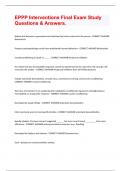EPPP Interventions Final Exam Study
Questions & Answers.
Believe that behavior is generated and maintained by factors external to the person - CORRECT ANSWER
Behaviorists
Propose psychopathology results form problematic learned behaviors - CORRECT ANSWER Behaviorists
Counterconditioning is based on ____, - CORRECT ANSWER Reciprocal inhibition
the notion that two incompatible responses cannot be experienced at the same time, the stronger will
overcome the weaker - CORRECT ANSWER Reciprocal inhibition (fear will inhibit pleasure)
include systematic desentization, sensate focus, assertiveness training, and aversive conditioning -
CORRECT ANSWER counterconditioning
The focus of treatment is on weakening the maladaptive conditioned response by strengthening an
incompatible or antagonistic response - CORRECT ANSWER counter conditioning
Developed by Joseph Wolpe - CORRECT ANSWER Systematic desensitization
Most commonly used to treat specific phobias - CORRECT ANSWER systematic desensitization
Specific phobias: Previous research suggested ______, but more recent found _________ to be most
efficacious - CORRECT ANSWER prolong and intense exposure (e.g., flooding)
Developed by Masters and Johnson - CORRECT ANSWER Sensate focus
Goal = pleasure to countercondition anxiety,
,Pleasure from massage, discontinued when anxious, abstain form intercourse initially, goal to have
pleasure during intercourse with no anxiety - CORRECT ANSWER Sensate focus
used for social anxiety, more effective coping styles - CORRECT ANSWER assertiveness training
Aversive counterconditioning, when it is done in imaginal - CORRECT ANSWER covert sentization
using antabuse is a form of _____ - CORRECT ANSWER in vivo aversive conterconditioning
thinking of cancer cells destroying your body while smoking is a form of - CORRECT ANSWER imaginal
aversive counterconditioning, or covert sentization
Used in the treatment of paraphilias - CORRECT ANSWER Aversive condtioning
Works in the short-term, but not effective in the long-term, high rates of recidivism - CORRECT ANSWER
aversive conditioning
The reason most fears don't extinguish naturally, is because people avoid the CS or quickly flee. So we
use - CORRECT ANSWER classical extinction
Example, present a spider (CS) while being prevented from fleeing. - CORRECT ANSWER Flooding
Research, ________ is more effective than multiple, briefer periods of exposure which can actually
exacerbate the fear. - CORRECT ANSWER Prolonged exposure (e.g, 45 minutes)
__________ appears to be more effective than systematic desensitization for agoraphobia, ocd, and
specific phobias - CORRECT ANSWER Flooding with response prevention
Implosive therapy, stampfl, feared object paired with psychosexual themes, psychosexual.......... -
CORRECT ANSWER did not add to treatment effectiveness
,Involves defining a target behavior, determining antecedents and consequences, identifying
contingencies - CORRECT ANSWER functional assessment of behavior (operant), behavior modification
reinforcers that reinforce everyone at all ages and all cultures - CORRECT ANSWER primary reinforcers
acquire reinforcing value through training or experience (e.g., praise) - CORRECT ANSWER secondary
reinforcers
not inherently reinforcing, take on value because they give access to other reinforcers, (e.g., token
economy) - CORRECT ANSWER generalized conditioned reinforcers (e.g., money, tokens)
Example, an autistic child is being taught to say her name, and is reinforced initially for making
vocalization, them saying the beginning, and so forth until she does - CORRECT ANSWER shaping
the therapist helps people involved to identify the behaviors they most want from one another, and
then helps them negotiate a contract for their exchange - CORRECT ANSWER contingency contracting
Example, requiring a child to eat her peas before going out to play. - CORRECT ANSWER The premaack
principle (couple a low frequency behavior with a high frequency behavior)
Example - a hyperactive child is ignored when she speaks out of turn (extincition), reinforced when she
wait her turn or performs other preferred behaviors (reinforcement) - CORRECT ANSWER Differential
reinforcement of other behaviors DRO
Example - implementing a weight management program, a person rewards himself for each pound lost -
CORRECT ANSWER Self-reinforcment
on keeps a detailed record of what one does, such as everything one eats - CORRECT ANSWER self-
montoring
Example- eating only at specific times at a specific table (narrow stimuli), or going for a walk instead of
snacking (incompatible responses) - CORRECT ANSWER stimulus control
, Example- client snaps a rubber band on wrist whenever thinking of an undesirable thought - CORRECT
ANSWER Thought stopping - positive punishement
Research has found that _________ merely suppresses behavior but does not eliminate it - CORRECT
ANSWER punishment
When using punishment, it should be used ____ in the cycle, there should be _____ delay, and _____
intensity should be used the first time. - CORRECT ANSWER early, little, maximum
Example- animal shocked until presses a lever, mugged at gunpoint and can only make the assailant go
away by giving wallet - CORRECT ANSWER escape learning
In _____ learning one can't avoid aversive stimulus but can stop it by emitting desired behavior, in
______ learning one can entirely avoid it by emitting. - CORRECT ANSWER Escape, avoidance
Example - red light flashes, cueing animal to press lever---bills "pay before"date, avoid late penalties and
fees - CORRECT ANSWER avoidance learning
Example - a child makes a mess in the living room, he is not only required to clean up the living room,
but also to clean up another room. - CORRECT ANSWER Overcorrection
Applied in the treatment of phobias, to improve social skills, and to repair behavioral deficits. - CORRECT
ANSWER Modeling procedures
involves observing a film I which a model enjoys progressively more intimate interaction with a feared
object or anxiety-producing setting. - CORRECT ANSWER Symbolic Modeling
entails having a person observe a live model engage in graduated interactions with a feared object or
anxiety-producing situation - CORRECT ANSWER Live or in-vivo modeling
particularly appropriate for children with phobias - CORRECT ANSWER participant modeling




